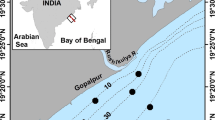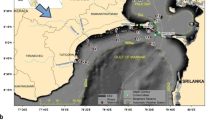Abstract
The accuracy of satellite derived chlorophylla (chla) using empirical algorithms (OC2 and OC4) is about ± 30–35%, which is attributed mainly to the sensor and atmospheric constraints and also the bio-optical algorithms. However errors inin situ measurement of chla may also contribute to the retrieval accuracy. The fluorometric method of chla measurement can significantly under or overestimate chla concentrations. This is mainly because of the overlap of the absorption and fluorescence bands of co-occurring chlorophyllsb andc, chlorophyll degradation products, and accessory pigment. Accurate chla measurements are important for validating satellite derived chla accuracy and algorithm development. The focus of this study was to understand the discrepancy between fluorometric and HPLC (High Performance Liquid Chromatography) derived chla using unialgal cultures, natural field samples from Bedford Basin and samples from MinOx cruise to analyse divinyl chla. Approximately 50% underestimation of chla both in the natural samples as well as cultured samples has been observed by fiuorometer. The results of MinOx cruise data indicated shifting of the blue absorption maxima towards longer wavelengths (~450nm), which is consistent with high concentration of divinyl chla (chla 2) associated with prochlorophytes.
Similar content being viewed by others
References
Bianchi, T.S., Lambert, C. and Biggs, D.C. (1995). Distribution of chlorophylla and phaeopigments in the northwestern Gulf of Mexico: a comparison between fluorometric and high performance liquid chromatography measurements.Bull. Mar. Science,56: 25–32.
Bidigare, R.R., Kennicutt, M.C. II and Brooks, J.M. (1985). Rapid determination of chlorophylls and their degradation products by HPLC.Limnol. Oceanogr,30(2): 432–435.
Bidigare, R.R., Heukelem, L.V. and Trees, C.C. (2002). HPLC phytoplankton pigments: sampling, laboratory methods, and quality assurance procedures. NASA/ TM-2002-210004/Rev3-,12: 258–268.
Goericke, R. and Repeta, D.J. (1993). Chlorophyllsa andb and divinyl chlorophylls in the open subtropical North Atlantic Ocean.Mar. Ecol. Prog. Ser.,10: 307–313.
Goericke, R. and Repeta, D.J. (1992). The pigments ofProchlorococcus marinus: The presence of divinyl chlorophylla andb in marine prochlorophytes.Limnology and Oceanography,37: 425–433.
Head, E.J.H. and Home, E.P.W. (1993). Pigment transformation and vertical flux in an area of convergence in the North Atlantic.Deep-Sea Res.,1(40): 329–346.
Hoepffner, N. and Satyendranath, S. (1991). Effect of pigment composition on absorption properties of phytoplankton.Mar. Ecol. Prog. Ser,73: 11–23.
Loftis, M.E. and Carpenter, J.H. (1971). A fluorometric method for determining chlorophylla, b, c.J. Mar. Res.,29: 319–338.
Moore, L.R., Goericke, R. and Chisholm, S.W. (1995). Comparative physiology ofSynechococcus andProcholorococcus: Influenec of light and temperature on growth, pigments, fluorescence,and absorptive properties.Mar. Ecol. Prog. Sen,116: 259–275.
Morel, A., Ahn, Y.W., Partensky, F., Vaulot, D. and Claustre, H. (1993).Procholorococcus andSynechococcus: A comparative study of their size, pigmentation and related optical properties.J. Mar. Res.,51: 617–649.
Parsons, T.R., Maita, Y. and Lalli, CM. (1984). A Manual of Chemical and Biological Methods for Seawater Analysis. Pergamon Press, Oxford, UK, 173p.
Smith, R.C., Bidigare, R.R., Prezelin, B.B., Baker, K.S. and Brooks, J.M. (1987). Optical characterization of primary productivity across a coastal front.Mar. Biol,96: 575–591.
Tester, P.A., Geesey, M.E., Guo, C., Paerl, H.W. and Millie, D.F. (1995). Evaluating phytoplankton dynamics in the Newport river estuary by HPLC-derived pigment profiles.Mar. Ecol. Prog. Sen,124: 237–245.
Trees, C.C., Bidigare, R.R., Karl, D.M. and Van Heukelem, L. (2000). Fluorometric chlorophyll a: Sampling, laboratory methods, and data analysis protocols, NASA Tech. Memo., 2000–209966: 162–169.
Trees, C.C., Clark, D.K., Bidigare, R.R., Ondrusek, M.E. and Mueller, J.L. (2000). Accessory pigments versus chlorophyll a concentrations within the euphotic zone: a ubiquitous relationship.Limnol. Oceanogn,45:1130–1143.
Wright, S.W., Jeffrey, S.W., Mantoura, R.F.C, Llewellyn, CA., Bjornland, T., Repeta, D. and Welschmeyer, N. (1991). Improved HPLC method for the analysis of chlorophylls and carotenoids from marine phytoplankton.Man Ecol. Prog. Sen,77: 183–196.
Author information
Authors and Affiliations
Corresponding author
About this article
Cite this article
Kumari, B. Comparison of high performance liquid chromatography and fluorometric ocean colour pigments. J Indian Soc Remote Sens 33, 541–546 (2005). https://doi.org/10.1007/BF02990739
Received:
Revised:
Issue Date:
DOI: https://doi.org/10.1007/BF02990739




